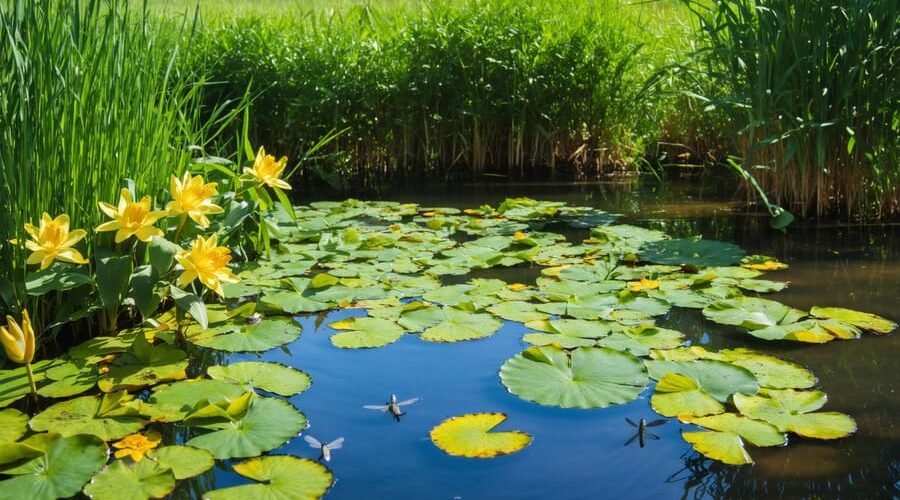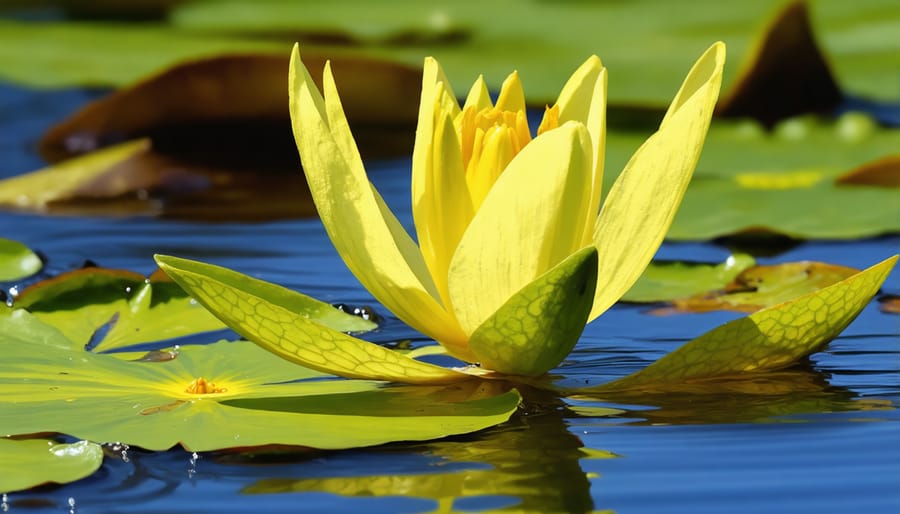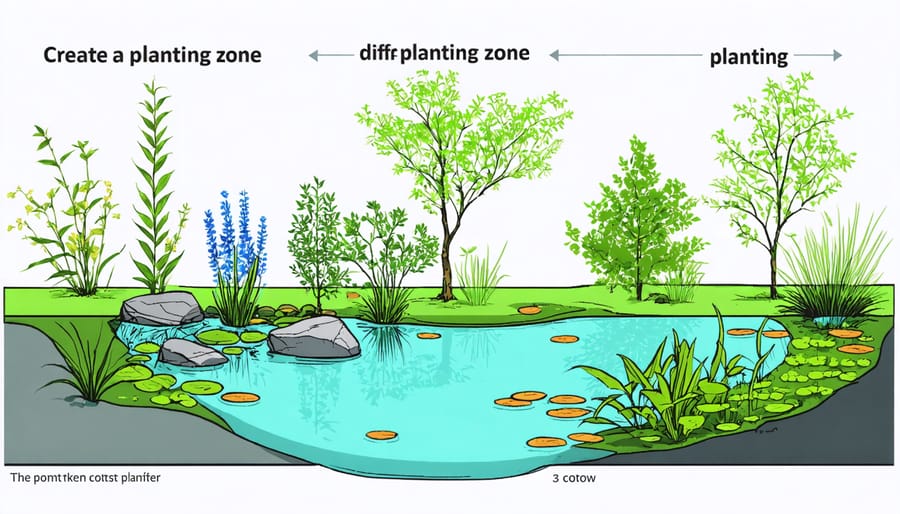
Transform Your Pond with Oregon’s Native Plants (A Natural Paradise Guide)
Transform your pond into a vibrant Oregon ecosystem by selecting native aquatic plants that thrive in the Pacific Northwest’s unique climate. Transform your pond with native plants like wapato, yellow pond lily, and marsh cinquefoil to create natural filtration, provide wildlife habitat, and maintain water clarity year-round. These indigenous species evolved alongside local wildlife, requiring minimal maintenance while supporting native pollinators, birds, and beneficial insects. Beyond their ecological benefits, Oregon’s native pond plants offer stunning seasonal displays, from delicate spring blooms to rich autumn colors, creating a dynamic water feature that connects your landscape to the region’s natural heritage. Whether you’re establishing a new pond or enhancing an existing water garden, native species provide the foundation for a sustainable, low-maintenance aquatic environment that captures the essence of Oregon’s wetland ecosystems.
Why Choose Oregon Native Pond Plants?

Environmental Benefits
Oregon native pond plants play a crucial role in maintaining healthy aquatic ecosystems. These plants naturally filter water by absorbing excess nutrients and pollutants, helping to keep your pond clean and clear. As natural water purifiers, they reduce the need for chemical treatments and artificial filtration systems.
Native plants are particularly effective at preventing erosion along pond edges, their strong root systems holding soil in place during heavy rains and high water events. They also provide essential shelter and breeding grounds for local wildlife, helping to increase pond biodiversity and create a thriving micro-ecosystem.
By choosing native species, you’re supporting local pollinators like bees and butterflies, while also providing food and habitat for native birds, frogs, and beneficial insects. These plants are naturally adapted to Oregon’s climate, requiring less maintenance and water than non-native alternatives. They’re also resistant to local pests and diseases, reducing the need for pesticides that could harm aquatic life.
Additionally, native pond plants help regulate water temperature by providing shade, which is essential for fish and other aquatic creatures during hot summer months.
Practical Advantages
Oregon native pond plants are incredibly low-maintenance compared to non-native species, making them a smart choice for busy pond owners. These plants have evolved to thrive in our local climate and naturally resist common pests and diseases that plague exotic varieties. You won’t need to fuss with chemical treatments or complex care routines.
These hardy natives have developed natural defenses against local wildlife and insects, reducing the need for artificial pest control. They’re also well-adapted to Oregon’s seasonal changes, meaning they can handle our wet winters and occasional summer dry spells without extra attention.
Another practical advantage is their ability to compete with invasive species. Native plants form strong root systems and establish themselves quickly, naturally preventing unwanted plants from taking over your pond. They also provide natural filtration, helping to keep pond water clear and healthy with minimal intervention.
Maintenance typically involves basic seasonal cleanup and occasional division of spreading plants – that’s it! No special fertilizers or protective measures needed, saving you time and money while creating a more sustainable water garden.
Best Native Pond Plants for Oregon
Marginal Plants
Oregon’s pond margins offer the perfect habitat for a diverse array of native plants that thrive in moist soil conditions. Rush species, including the striking Common Rush (Juncus effusus) and the delicate Spreading Rush (Juncus patens), add vertical interest with their deep green, cylindrical stems. These hardy plants not only look beautiful but also help stabilize pond edges and provide shelter for small wildlife.
Sedges are another fantastic choice for pond margins. The versatile Slough Sedge (Carex obnupta) features graceful, arching leaves and adapts well to varying water levels. Dense Sedge (Carex densa) forms attractive clumps and helps prevent soil erosion along pond banks.
For stunning blooms, consider adding Western Blue Flag Iris (Iris missouriensis), which produces lovely purple-blue flowers in late spring. Yellow Monkey Flower (Mimulus guttatus) brings cheerful splashes of color and attracts beneficial pollinators to your pond area.
These marginal plants are easy to maintain and naturally adapt to Oregon’s climate. When planting, space them about 12-18 inches apart in the moist soil around your pond’s edge. Most prefer full sun to partial shade and will spread gradually to create a lush, natural-looking border. Remember to trim back dead foliage in late winter to encourage healthy spring growth and maintain the pond’s aesthetic appeal.
Floating Plants
Oregon’s native floating plants add a beautiful dimension to any pond, with the Yellow Pond-Lily (Nuphar polysepala) being our state’s crown jewel. These magnificent plants spread their large, heart-shaped leaves across the water’s surface, creating natural shade and shelter for pond life below.
The Yellow Pond-Lily, also known as Indian Wokas, produces stunning yellow flowers that rise several inches above the water from late spring through summer. These blooms not only add visual interest but also provide essential food for local pollinators and waterfowl.
Another excellent native floating option is the Western Water Shield (Brasenia schreberi), which features oval floating leaves with a peculiar gelatinous coating underneath. This coating helps protect the plant from aquatic herbivores and adds to its unique character.
When incorporating floating plants, start with just a few specimens as they can spread vigorously in favorable conditions. Plant them in submerged containers filled with heavy clay-based soil, positioning them so the crown sits just below the water’s surface. These plants prefer full sun to partial shade and typically thrive in water depths between 2 and 6 feet.
For best results, place floating plants away from waterfalls or strong currents, as they prefer calm waters. During winter, most native floating plants will naturally die back but return vigorously in spring, requiring minimal maintenance throughout the year.

Submerged Plants
Submerged plants play a vital role in maintaining the health and balance of your Oregon pond ecosystem. One of the most prevalent native underwater species is the Common Mare’s Tail (Hippuris vulgaris), which forms dense underwater forests that provide excellent habitat for aquatic life. When planning your underwater plant selection, consider including Water Milfoil and Coontail, which naturally occur in Oregon’s waterways.
These submerged plants work tirelessly beneath the surface, absorbing excess nutrients and helping prevent algae growth. They also provide shelter for small fish and aquatic insects, making them essential for a thriving pond ecosystem. Common Mare’s Tail is particularly well-suited to Oregon’s climate, thriving in depths between 6 inches and 2 feet, with its feathery leaves creating an attractive underwater landscape.
For best results, plant these submerged species in spring when water temperatures begin to warm. Secure them in small mesh baskets with aquatic soil and a layer of gravel on top to prevent floating. Space plants about 12-18 inches apart to allow room for growth. Remember that while these plants may seem slow to establish at first, they’ll spread naturally over time, creating a beautiful underwater garden that helps keep your pond crystal clear and healthy.
Bog Plants
The transitional area between your pond and garden offers the perfect habitat for fascinating native bog plants. These moisture-loving species thrive in the consistently damp soil around pond edges, creating a lush, natural border while helping filter runoff water.
Oregon’s native Camas lilies, with their striking blue-purple blooms, make excellent bog garden additions, particularly in spring. Tufted hairgrass adds beautiful texture and movement, while spreading rush provides year-round greenery and essential wildlife habitat. The cheerful yellow flowers of marsh marigolds brighten up wet areas in early spring, and native sedges offer architectural interest with their distinctive forms.
For stunning summer color, try the cardinal flower with its brilliant red blooms that attract hummingbirds, or the delicate pink flowers of Western spiraea. The versatile Western columbine adapts well to varying moisture levels, making it perfect for areas that occasionally dry out.
When planting your bog garden, arrange taller species like rushes and sedges toward the back, with shorter plants like marsh marigolds in front. Add a layer of gravel or small stones around plants to keep soil from washing away during heavy rains. Most bog plants establish best when planted in spring, giving them time to develop strong root systems before winter.
Remember to maintain consistent soil moisture for these plants, especially during Oregon’s drier summer months. Regular mulching helps retain moisture and suppress unwanted weeds.
Planting and Maintenance Tips

Planting Zones and Timing
Oregon’s unique climate creates distinct planting zones that influence when and where to establish native pond plants. Most native aquatic plants thrive best when planted in spring, typically from March through May, when water temperatures begin to warm but before the intense summer heat arrives.
For shallow marginal areas (0-6 inches deep), plant moisture-loving species like Blue-eyed Grass and Pacific Rush in early spring. These plants establish quickly and provide essential habitat for wildlife near the water’s edge. In slightly deeper zones (6-12 inches), introduce Marsh Cinquefoil and Common Spikerush during late spring when water temperatures are consistently above 50°F.
Deep-water plants like Wapato and Yellow Pond Lily should be planted in zones ranging from 1-4 feet deep. Wait until mid-spring when water temperatures reach 60°F for optimal growth conditions. For floating plants such as Western Water Lily, ensure placement in areas with at least 2-3 feet of water depth and full sun exposure.
Western Oregon gardeners can generally start planting earlier in the season compared to those in Eastern Oregon, where frost risks persist longer. Coastal areas benefit from milder temperatures, allowing for extended planting windows into early summer.
Remember to consider your specific USDA hardiness zone within Oregon (typically zones 6-9) when selecting plants. Most native species are well-adapted to local conditions but may perform differently based on elevation and microclimate. For best results, group plants with similar water depth requirements together and ensure adequate spacing for future growth.
Seasonal Care Guide
Oregon native pond plants require different care throughout the year to maintain their health and beauty. Understanding proper seasonal pond maintenance is key to success with these aquatic plants.
In spring, remove any dead foliage from the previous year and divide overcrowded plants before new growth begins. This is also the perfect time to add fertilizer tablets specifically designed for aquatic plants. Watch for emerging shoots and protect them from late frosts with floating row covers if necessary.
Summer care focuses on managing plant growth and maintaining water quality. Remove yellowing leaves promptly and trim back aggressive spreaders to prevent them from overtaking the pond. Keep floating plants like watershield from covering more than 60% of the water surface to maintain oxygen levels.
Fall preparation is crucial for winter survival. Cut back marginal plants to about 2-3 inches above the water line, and remove fallen leaves before they sink and decompose. Some native species, like wapato and marsh marigold, can be left standing to provide winter interest and wildlife habitat.
During winter, most Oregon native pond plants enter dormancy and require minimal care. Avoid breaking ice on the pond surface, as this can shock the plants. If your pond is shallow (less than 18 inches), consider moving sensitive species to deeper water or using a pond heater to prevent freezing damage to plant roots.
Year-round, maintain consistent water levels and remove any invasive species that may appear. Remember that native plants are generally hardy but appreciate regular monitoring and timely intervention when needed.
Creating a pond with Oregon native plants is an enriching journey that connects your garden to the local ecosystem while providing beauty and functionality. By choosing native species like Wapato, Yellow Pond-Lily, and Western Blue Flag Iris, you’re not only creating a stunning water feature but also supporting local wildlife and maintaining ecological balance.
Remember that successful pond plantings start with understanding your specific conditions and selecting plants that match your pond’s depth, sunlight, and water flow. The diverse selection of Oregon natives offers solutions for every zone of your pond, from deep-water plants to marginal species that thrive along the edges.
Maintenance doesn’t have to be overwhelming. With proper planning and plant selection, your native pond garden can become largely self-sustaining. The key is starting with healthy specimens, planting them at the right depth, and giving them time to establish themselves.
Whether you’re a seasoned water gardener or just starting your first pond project, Oregon’s native aquatic plants offer endless possibilities for creating a thriving ecosystem. Begin with a few hardy species and gradually expand your collection as you gain confidence. Your pond will reward you with year-round interest, visiting wildlife, and the satisfaction of preserving Oregon’s natural heritage in your own backyard.
Take the plunge and start your native pond garden today – your local ecosystem will thank you!
